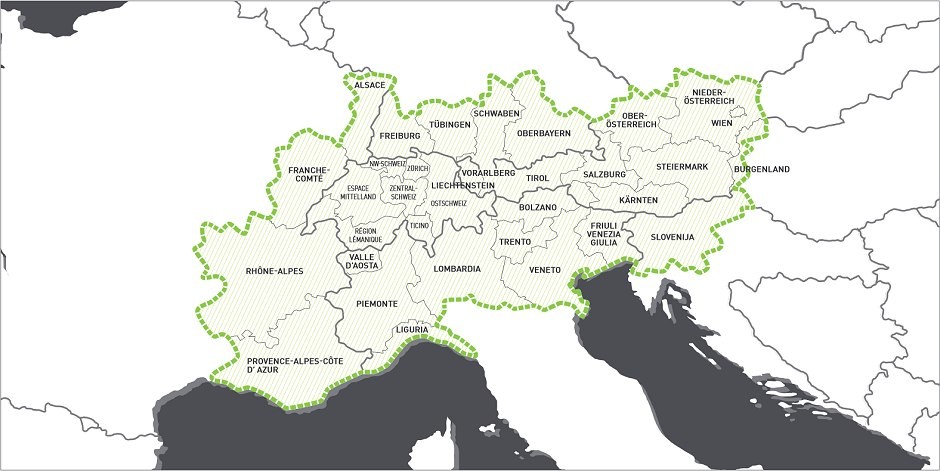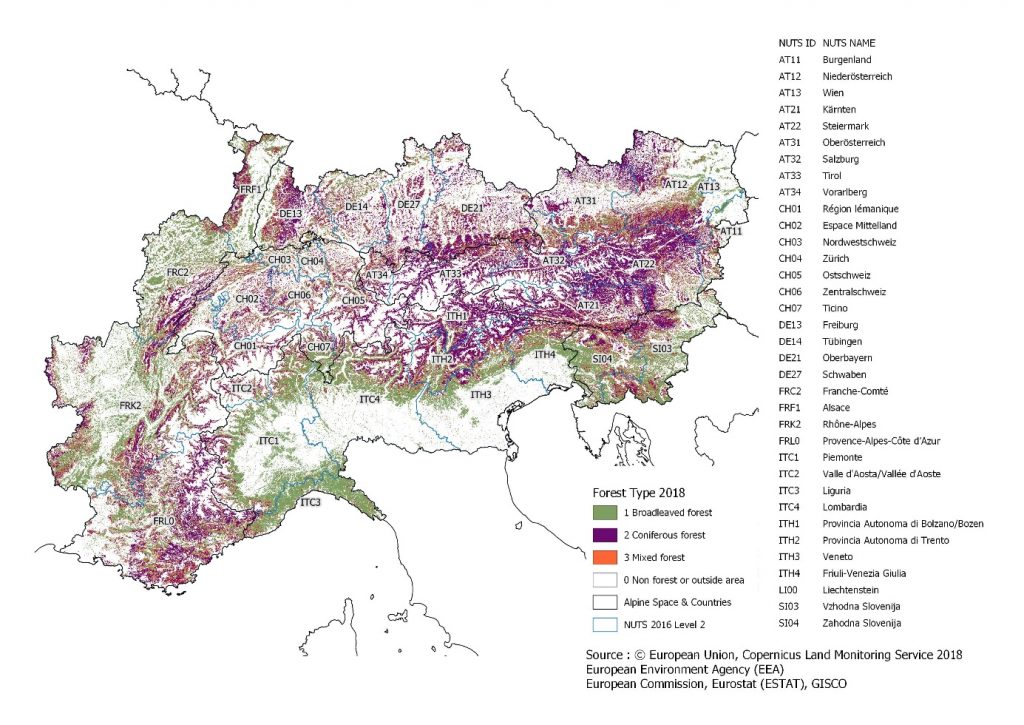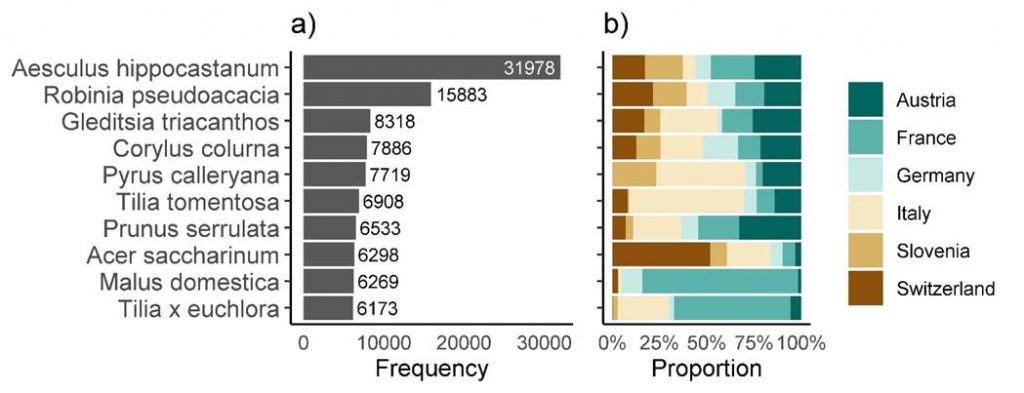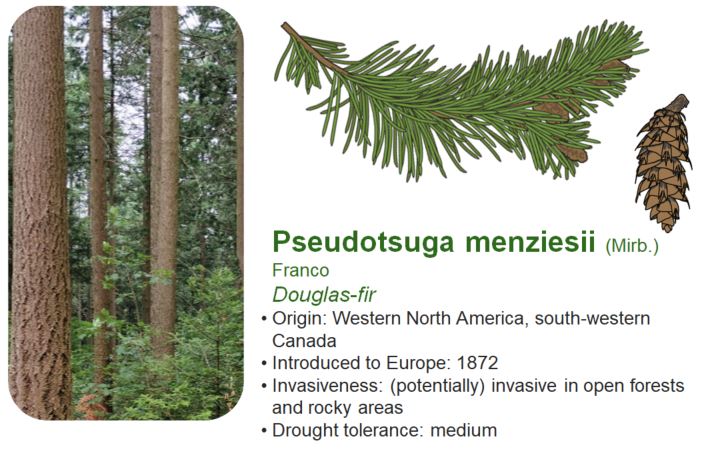
The Alpine Space, as defined by the European Interreg Alpine Space program, spans across an extensive region (390.000 km²) of several European countries: Austria, France, Germany, Italy, Slovenia, Liechtenstein, and Switzerland. Likewise, some of the most important European metropolitan areas with a total population of over 70 million inhabitants are located in this region. Almost two-thirds of the plants on the European continent are present in four biogeographic regions (Continental, Alpine, Mediterranean, and Pannonian Region) crossing the Alpine Space. The Alpine Space is one of the most responsive hot spots for climate change and is among the richest areas in Europe in terms of biodiversity in many sensitive ecosystems. It will likely face more severe consequences of both climate change and the biodiversity crisis than other parts of Europe, as climate warming is advancing at faster rates than the average warming of the northern hemisphere.
In the Alpine space, 42,5 % of the total land area is covered by forests, with a positive trend of increase for the forested areas. 6,3 million ha are covered by coniferous forests, 7,2 million ha by broadleaved ones, and 3,2 million ha by mixed forests. Forest resources should not be considered as a monolithic entity. Instead, they play a multifaceted role, with complex patterns and relationships among forests and other natural areas, their use, and their interaction with other anthropogenic systems.


Climate change and human activity represent major threats to the ecosystems in the Alpine space. Therefore, adaptation efforts are required to respond to expected negative effects on Alpine environments, economies, and societies. Non-native trees (NNT) can support the adaptation of European forests and urban areas to climate change, but they simultaneously entail risks for biodiversity and ecosystem functions. During the last decades the number of NNT in planted forests has increased worldwide. However, the number of NNT in forests of the Alpine Space remains relatively low. Although 526 NNT – compared to 110 native tree spieces – were identified in total in the Alpine Space in the year 2021, the majority of them (67%) are currently cultivated exclusively in urban areas, where they are important components of the green infrastructure. Most of the reported NNT in the Alpine Space (90%) have their natural distribution range outside of Europe, especially in Asia and in North America.
Data on non-native trees
The results of the ALPTREES Inventory of NNT show that at least 526 NNT are currently growing in forests and urban areas in the Alpine Space. The number of NNT growing in urban areas (352) is much higher compared to woodlands (13), yet a considerable large number were reported for both urban areas and forests (161). These figures clearly show that a large proportion (67%) of reported NNT are currently being cultivated exclusively in cities in the Alpine Space. Of these, the most common NNT are Aesculus hippocastanum (horse chestnut), Robinia pseudoacacia (black locust), and Gleditsia triacanthos (honey locust). While some species such as A. hippocastanum, are planted fairly evenly across countries, Acer saccharinum is primarily found in Switzerland, and Malus domestica (Borkh.) and Tilia x euchlora (K.Koch) in France.Differences in the numbers and proportions of NNT between countries may be influenced by the quality and number of studies being available. For example, the number of tree inventories of cities varies greatly between countries. Based on our experience with data analysis, it has been shown that the number of NNT increased with the number of tree cadastres included. Therefore, we assume that tree diversity in some urban regions is actually even greater than previously represented by the data. Although the data collected in the urban areas differ slightly between cities, each city had at least accurate data on individual trees and species.
Non-native trees in urban areas
Urban trees provide significant ecosystem services, such as sequestering carbon, removing air pollutants, and regulating the microclimate, thus contributing to the overall improvement of the environment and quality of life. The cultivation of non-native tree species in European cities has a long tradition, but the tree species, current numbers, and geographical distribution of these species in European cities and urban areas are largely unknown. In the ALPTREES project, we create a database with comprehensive data on NNT in cities and forests. The introduction of NNT in the Alpine space has started in the 19th century – mainly for ornamental purposes. Some oldgrown individuals are still alive today in the botanical gardens. Almost a hundred years ago the interest in NNT for use in forests started to grow due to their resistance to pests, droughts, and fast growth. But the introduction of NNT to urban areas did not inherit only benefits. Some NNT have spread from cultivation sites into semi-natural ecosystems, where they can potentially outcompete native species, change the species composition and cause irreversible harm to biodiversity. Although the number of urban NNT is very high due to their benefits for the urban areas, they are also affected by the changing climate as most likely urbanized areas will be hotspots of the projected temperature increase. In consequence, some tree species might become unsuitable and increased climatic extremes could lead to an increased susceptibility of urban trees to certain pests and diseases.

However, selecting the right species is a challenge, as the most guidance is focused on trees aesthetic values and ecosystem service delivery, very often neglecting the importance of trees ability to cope with different biotic and abiotic stress factors. Additional challenge for urban foresters is to target the most appropriate tree species for selected urban sites under projections of future climatic conditions, imposing the need for understanding the species climate-adaptation properties and environmental stress tolerance. So far, a solution has been sought mainly in the use of suitable indigenous species and local provenances, while the use of NNT was significantly burdened by the negative public perception, although numerous studies demonstrated higher drought tolerance of NNT growing in urban areas compared to autochthonous species. Nevertheless, in order to mitigate negative effects of climate change and maximize ecosystem services, the use of urban trees should not rely only on the planting of autochthonous tree species, but should also consider selection of other provenances and NNT.
The Interreg-funded ALPTREES project
The expected benefits and potential risks of the use of non-native trees for the regions of the Alpine space have polarized the opinions of experts and citizens. Benefits include adaptation to climate change, contributions to bioeconomy, urban and peri-urban green infrastructure, and mitigation of natural hazards, while risks include invasiveness by non-native tree species and their effects on native biodiversity. The distinction between non-native and native is important because some non-native tree species are considered invasive and can alter the ecosystem of the area they grow in. Observing nature and being able to identify potentially invasive species can help to better evaluate the dissemination of non-native species and their invasiveness in forests and cities. The Interreg-funded ALPTREES project is dedicated to investigating the opportunities and risks that non-native tree species provide for the future of our urban und forest areas as well as developing guidelines for their use and management within the Alpine space.
Further Reading & Resources:
Interreg Alpine Space Programme – Alpine Space Programme
Interreg is a series of programs for the cohesion between regions in and out of the European Union. The Interreg Alpine Space program co-finances and supports cooperation projects across the borders of seven Alpine countries. More information is available at: https://www.alpine-space.eu/
The Alpine Convention
More information is available at: https://www.alpconv.org/en/home/
EUSALP – EU Strategy for the Alpine region
A ‘Macroregional strategy’ is an integrated framework endorsed by the European Council, which may be supported by the European Structural and Investment Funds among others, to address common challenges faced by a defined geographical area relating to Member States and third countries located in the same geographical area which thereby benefit from strengthened cooperation contributing to achievement of economic, social and territorial cohesion. More information is available at: http://alpine-region.eu/
A transnational cooperation for sustainable use and management of non-native trees in urban, peri-urban and forest ecosystems in the Alpine region (ALPTREES)
Lapin K, Bindewald A, Kraxner F, Marinšek A, La Porta N, Hazarika R, et al. A transnational cooperation for sustainable use and management of non-native trees in urban, peri-urban and forest ecosystems in the Alpine region (ALPTREES). Res Ideas Outcomes. 2020;6(33). https://riojournal.com/article/53038/list/18/
ALPTREES Report on Urban NNT assessment in the Alpine Space
Stojnić Srđan, Bindewald Anja, Lapin Katharina, Kraxner Florian: Urban non-native trees assessment in the Alpine Space, Interreg Alpine Space Project – Alptrees Report for D.T2.3.1 Report on Urban NNT assessment in the Alpine Space. 33 p. More information is available at: https://www.alpine-space.org/projects/alptrees/deliverables/deliverable-d-t2-3-1-report-on-urban-nnt-assessment.pdf
ALPTREES Project Leaflet
d.c.5.3-alptrees_leaflet_a5_engl.pdf
d.c.5.3_alptrees_leaflet_a5_fra.pdf
d.c.5.3_alptrees_leaflet_a5_ger.pdf
d.c.5.3_alptrees_leaflet_a5_ita.pdf
d.c.5.3_alptrees_leaflet_a5_slo-2.pdf




